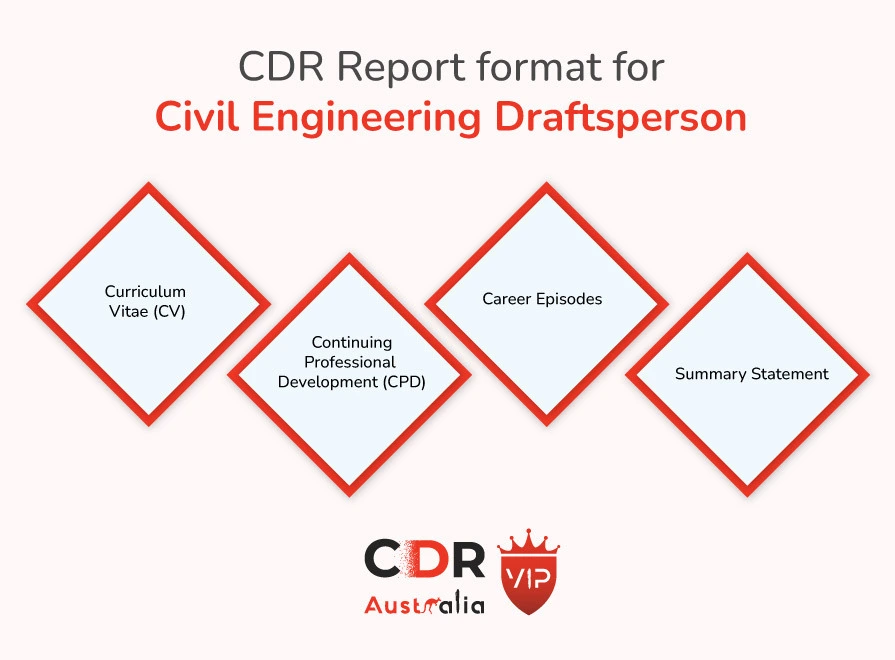How to migrate to Australia as a Civil Engineering Draftsperson?

How to migrate to Australia as a Civil Engineering Draftsperson?
Civil Engineering Draftsperson plays a crucial role in civil engineering projects. They create detailed plans and drawings for things like roads and bridges and need formal training in structural engineering or construction design to become one.
They fall under the Engineering Associate category in Australia, recognized by Engineers Australia. If you’re a Civil Engineer looking to work as a Civil Engineering Draftsperson in Australia, you must follow the Competency Demonstration Report (CDR) pathway. This process helps you prove your skills and qualifications for this role.
A Competency Demonstration Report (CDR) is crucial for individuals aspiring to become Civil Engineering Draftspersons in Australia. It serves as a document that evaluates your skills, qualifications, and experience, ensuring that they meet the standards of Engineers Australia, the assessing authority for engineering professions.
Role of a Civil Engineering Draftsperson
Before getting into the CDR process, it’s essential to understand the role of a Civil Engineering Draftsperson. In Australia, a Civil Engineering Draftsperson assists engineers in creating detailed technical drawings and plans for civil engineering projects. They play a vital role in turning conceptual designs into tangible construction plans.
Responsibilities of a Civil Engineering Draftsperson
As a Civil Engineering Draftsperson, your responsibilities may include:
- Creating Technical Drawings: Drafting precise engineering drawings and plans using computer-aided design (CAD) software.
- Assisting in Design: Collaborating with engineers to translate their designs into practical drawings.
- Quality Control: Ensuring accuracy and compliance with engineering standards in all drawings.
- Documentation: Maintaining comprehensive records of all drawings and revisions.
- Teamwork: Working closely with engineers, surveyors, and other professionals involved in construction projects.
Read More: What makes the perfect CDR for an Agricultural Engineer? 💪💪
CDR Report format for Civil Engineering Draftsperson
This format is crucial for those seeking to migrate to Australia as it helps assess your engineering skills and qualifications. CDR Report format of Civil Engineering Draftsperson gets divided into several sections, each with a specific purpose:

1. Curriculum Vitae (CV)
Your CV is like a detailed document that paints a picture of your educational background and work experience as a Civil Engineering Draftsperson. Think of it as your career map that highlights where you’ve been and what you’ve achieved.
This report includes your academic qualifications, the places you’ve worked, and any additional information like certificates and memberships in engineering organizations. Your CV should be thorough and concise, giving assessors a clear view of your qualifications.
Your Curriculum Vitae (CV) is your introduction to the EA. Here’s how to create an impressive CV:
- Include your Name, contact details, and a professional summary.
- Detail your educational background: List your degrees, institutions, and graduation dates.
- Highlight your work experience: Describe your roles, responsibilities, and achievements in previous jobs related to civil engineering drafting.
- Showcase your skills and achievements: Mention any certifications, awards, or special skills that set you apart.
2. Continuing Professional Development (CPD)
This section shows your commitment to ongoing learning and professional growth. Simply, it demonstrates that you’re always working on improving your job. Describe any workshops, courses, or training programs you’ve completed to enhance your skills as a Civil Engineering Draftsperson.
To document your Continuing Professional Development (CPD) activities effectively:
- Keep records of all CPD activities, including dates, topics, and durations.
- Reflect on how each activity contributed to your professional development.
- Compile your CPD records organized for inclusion in your CDR Report.
Read More: Why should you consider the Australian Professional Year Program? 💪💪
3. Career Episodes
Each career episode specifies a specific time or project in your career. These episodes are where you showcase your engineering skills and how you solve problems. For each episode, you follow a simple structure:
- The Situation: Set the stage by describing where and when the story happened and what the project was about.
- Your Role (Task): Explain your job and what you were responsible for in the project. What was your role in making it successful?
- Actions Taken (Actions): Describe the specific things you did during the project. How did you approach challenges? What were your contributions?
- Results Achieved (Results): Discuss the outcomes of your efforts. What positive impact did your actions have on the project or the organization? Use facts and figures to prove all of your achievements.
These episodes are like spotlight moments where you show how good you are at your job and how you help solve real engineering problems. When crafting your career stories, remember three key things:
- STAR Format: For each career episode, use the STAR format: Situation, Task, Actions, and Results. This episode helps organize your story and makes it easy to understand.
- Highlight Your Part: Focus on what you did in the project. Showcase your contributions and how you made a difference. It’s about you, not just the team’s efforts.
- Problem Solving: Engineers are like problem solvers. Use your career episodes to demonstrate your ability to identify and solve engineering challenges. Explain your problem-solving approach and the solutions you implemented.
4. Summary Statement
Think of the summary statement as the highlight reel of your engineering abilities. In this section, you concisely summarize your competencies and skills, aligning them with the elements of the CDR Assessment Criteria. This section gives assessors a quick overview of your engineering capabilities.
Read more: Engineers Australia Assessment Validity 💼💼
Critical elements of CDR Assessment Criteria
Now, let’s look at the critical elements of the CDR Assessment Criteria, which are divided into four categories based on your career stage:
1. Professional Engineer
Professional Engineers find unique solutions to engineering problems while considering the environment and society. They use organized methods to handle projects and use proven engineering techniques to solve challenging problems. They also focus on solving issues and reducing risks.
If you’re an experienced engineer, this category is for you. Your CDR should show your ability to:
- Apply Advanced Engineering Skills: Show your proficiency in complex engineering tasks.
- Innovation: Highlight your innovative contributions to projects.
- Leadership: Provide evidence of your leadership roles and responsibilities. Talk about how you lead teams and projects.
2. Engineering Associate
Engineering Associates focus on specific parts of a system. They follow established rules and steps. They assist with research, design, and keeping systems and equipment working. Engineering Associates also make and understand drawings and plans.
If you’re in the early or mid-career stage, focus on:
- Application of Engineering Skills: Explain how you apply engineering principles.
- Problem Solving: Emphasize your role in solving engineering problems.
- Teamwork: Describe your teamwork and collaboration skills. Show how you work well with others in your field.
3. Engineering Technologist
Engineering Technologists are experts in a particular technical area. They use known engineering methods and tools. They help improve engineering technology and often work on how different systems interact. They adjust existing engineering processes for different situations.
For those with a technologist background, illustrate your:
- Technical Skills: Showcase your technical expertise.
- Application of Engineering Methods: Describe how you apply engineering methods.
- Supervision: If applicable, demonstrate your supervisory roles and responsibilities. How have you managed and guided others in your field?
4. Engineering Manager
Engineering Managers make plans, policies, and strategies for engineering projects. They oversee engineering work in their organization. They ensure projects meet quality, cost, safety, and timing goals.
If you have managerial responsibilities, provide evidence of:
- Strategic Planning: Describe your involvement in strategic planning for engineering projects.
- Project Management: Highlight your project management skills. How have you successfully managed complex projects?
- Leadership: Showcase your leadership and team management abilities. How have you led and motivated teams to achieve engineering goals?
In summary, the CDR format for a Civil Engineering Draftsperson is like telling your professional story in an organized way. You share your educational journey, commitment to learning, career highlights, why you excel in your role, and how you solve engineering problems.
This format helps assessors understand your skills and qualifications, making it easier for you to pursue a rewarding career as a Civil Engineering Draftsperson in Australia.
Read More: Why should you consider the Australian Professional Year Program? 💪💪
Preparation for the CDR Review
Before you send in your CDR (Competency Demonstration Report), it’s crucial to fulfill some essential criteria:
1. Accuracy
First and foremost, review your entire CDR for accuracy and consistency. Ensure all the information you’ve provided is correct and there are no mistakes or contradictions. Accuracy is vital because it shows your attention to detail.
2. Plagiarism Check
You must ensure that all the content in your CDR is entirely your own and not copied from somewhere else. Use plagiarism-checking tools or software to ensure your work is 100% original. It’s like making sure you didn’t copy someone else’s homework.
3. Language Proficiency
Your CDR must be well-written and follow Australian English standards. This criteria means using the right words, grammar, and style. If English isn’t your first language, consider getting someone proficient in Australian English to review your CDR for language and writing quality.
Sample CDR Report for Civil Engineering Draftsperson
Engineers Australia provides sample CDR reports on their website if you want a better idea of how to assemble your CDR. These samples are templates that can guide you in structuring your CDR. They show you what a successful CDR looks like and can help you understand how to effectively present your qualifications and experiences.
Read More: How to Prepare an ACS RPL Report for a Database Administrator? 💪💪
Conclusion
Creating a report like the Competency Demonstration Report (CDR) is essential for Civil Engineering Draftspersons who want to show their engineering skills in Australia. This guide has given you a perfect overview of how to make your CDR, including the format, what you need to put in it, and some tips for doing well.
Show your skills and qualifications for working as a Civil Engineering Draftsperson in Australia with specific examples. Focus on what you’re good at, and make sure your report fits Engineers Australia’s rules for your job.
Remember, getting ready for this is a big deal, and being careful and paying attention to details is super important. And guess what? If you need help, CDRAustraliaVIP can assist you in preparing your CDR. Good luck with your goal of becoming a recognized Civil Engineering Draftsperson in Australia!


